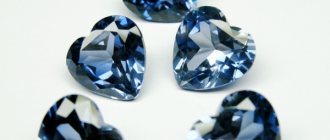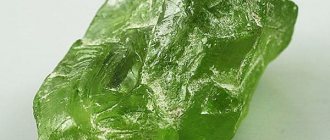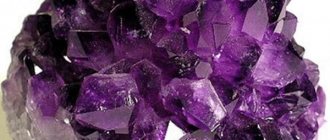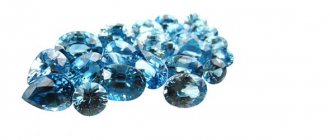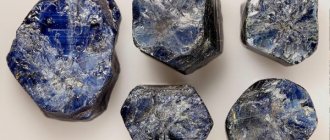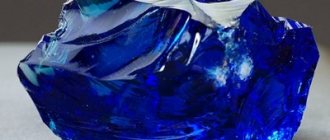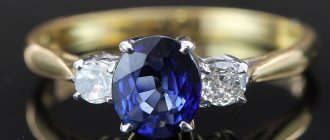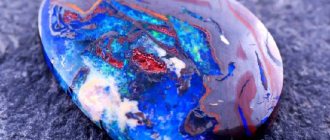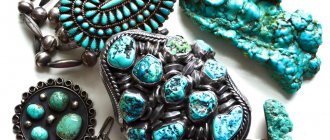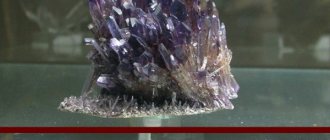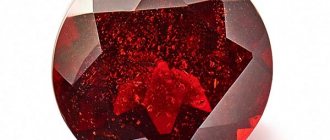Sapphire is a first tier gemstone. In terms of strength and beauty, it is inferior to few of its brothers. It is not surprising that such expensive beauty is sought to be counterfeited. A specialist can distinguish natural from artificial sapphire. But following simple rules will help you insure yourself against counterfeiting. Everyone will feel like a jeweler when experimenting with stones.
What does a gem look like?
The most popular crystals are in the classic blue range, from rich blue to violet.
- Natural stones are colorless, yellow, green, brown-orange. There are no red sapphires in this variety, these are rubies.
- The highest quality is moderate blue, the ideal color is cornflower blue.
- The velvety cornflower blue hue helps to distinguish real Kashmir stone.
- Burmese and Sri Lankan gems are famous for their “silk”. These are needle fibers intersecting at an angle of 60°. Visible under a magnifying glass.
The crystal is dichroic, that is, it splits the sun's rays. This creates a play of light and a bright glass shine.
Price
How much can a real sapphire cost? The price varies greatly depending on many factors - the origin of the crystal, its weight, purity, cut, etc. For example, in a jewelry store, earrings with natural sapphire of 2 carats cost from 30 thousand rubles. There are many offers on the Internet to buy natural sapphire and the range of prices is impressive: from 500 rubles. for a large stone up to 5000 per 1 carat. A ring with a 0.33 carat natural sapphire can be purchased in a well-known jewelry chain for 12-20 thousand rubles.
If you look at prices on the world market of precious minerals, then most often corundum is found and sold at a cost of 100-300 dollars per carat. Valuable specimens from Burma and Kashmir will cost several times higher.
“Analogs” of sapphire offered on the market
There are several imitations of the precious stone:
- outright fakes;
- doublets;
- artificially grown specimens;
- less expensive natural gems.
There are general identification methods and separate ones for each group.
Fakes
Ordinary bottle glass is passed off as a precious stone. It is not difficult to recognize it - the bubbles inside, unlike synthetic or natural minerals, heat up immediately in your hands.
Doublets
There are a lot of composite stones on the jewelry market, made up of several layers - doublets, triplets. The top of the product is a real sapphire, the bottom is glass, an artificial crystal or a cheap gem. The gluing is detected by examining the product under a magnifying glass.
They actively counterfeit jewelry in frames that hide the problematic part of the crystal.
Artificial stones
The official way to obtain gems. A popular method is the Verneuil technology. Source materials – natural corundum chips, chromium, titanium, iron. Vanadium, nickel, magnesium or cobalt oxide is added for pigmentation. Crystals are obtained by firing under pressure. Used in medicine, engineering, technology. Sapphire crystal is found in airplanes, rockets, and branded watches.
The grown artificial sapphire copies the characteristics of the original, in some cases it surpasses it, so it is difficult to recognize. The main marker is the much lower price.
Other natural gems
Natural cheap stones are passed off as sapphire:
- kyanite;
- tanzanite;
- tourmaline;
- spinel.
To recognize a stone, a refractometer is used - a device that determines the degree of refraction of light. The result is checked to the second decimal place. It has a refractive index of 1.76–1.77, while spinel has a refractive index of 1.72. A deviation of 0.01 indicates a different stone.
In addition, tanzanite is identified by its reddish background. Blue spinel specimens, distinguished by their dark shade, are passed off only as low-grade sapphire. Kyanite has a banded color structure. Only a jeweler can distinguish sapphire from tourmaline using a special composition.
Application
Natural sapphire is a gemstone that is mainly used in jewelry. But there are also artificial stones, which are also widely used to create jewelry. Chemically pure aluminum oxide, without impurities, is absolutely transparent - such stones are called leucosapphires and are used in ophthalmology, for the production of precision optical parts, protective glasses in aviation, for the manufacture of laser equipment, as well as elements of various installations where resistance to high temperatures is required.
Mechanical impact
A natural gem has sharp corners and smooth edges. In terms of hardness and strength, it is inferior to the strongest crystal – diamond. Only the same sapphire or diamond can damage it. But it easily scratches a hard surface, like glass.
You can check a sapphire by drawing a groove. Nothing will happen to the natural one; a mark will remain on the fake.
But this is not an absolute indicator. Tourmaline also scratches glass.
It is better to recognize a gem in this way in an inconspicuous area.
Foreign matter analysis
Natural conditions and the thousands of years during which crystals form differ from those in the laboratory. Therefore, you can determine the authenticity of a crystal visually:
- A high-quality stone must have inclusions and a heterogeneous structure. Visible under a magnifying glass or in bright daylight.
- The inclusions, visible to the naked eye, are characteristic of natural low-grade specimens.
- This one does not contain gas bubbles like glass. But this is not a 100% method, because the authors of the fakes have studied similar things.
- To determine the origin, the sample is placed in a jar of monobromonaphthalene. The container is placed on white paper and a light source is placed on the side. With this lighting, inclusion-strips are visible. In natural stone they are straight, in fake ones they are curved.
Specimens with the asterism effect, that is, inclusion in the form of a six-rayed “star,” are valued. It is easy to distinguish such a sapphire from a fake. With a smooth rotation of a natural gem, the star moves, but the imitation one remains in the center. They cannot fake the effect yet.
Color
A good way to check authenticity. The color of a natural crystal does not change under different lighting conditions. Therefore, the sample is evaluated outside during the day, then under the light of a light bulb. A difference of several tones indicates a fake.
If the certificate indicates that the stone has undergone heat treatment, it is checked under ultraviolet light. Synthetic ones will have a greenish tint, while natural ones have white highlights.
Color Enhancement
This becomes possible by filling the cavity with a coloring pigment. The substance used is oil-based dyes. Sometimes an aqueous or alcohol solution is used. The method is imperfect - the contour shade is unstable. In this case, the dye can leak out during the use of the stone. To check for the presence of pigment, you need to take a cotton swab soaked in acetone and press it against the surface of the sapphire. A painted specimen will definitely leave a mark.
Most often, sapphire stones are classified into natural and imitation. Moreover, a lot depends on the processing. If a beryllium-based method is used, the mineral is classified as a natural stone. When filling a cavity with lead or silicate, as well as carrying out diffuse manipulation based on titanium or chromium, the product is considered an imitation.
Formal methods
Since none of the methods available to the average consumer to verify the authenticity of a sapphire is reliable, specialists are involved in the process. The certificate or passport is studied independently.
Verification of documents
In order not to pay a lot of money for synthetics, purchases are made in salons with an impeccable reputation, where they will provide a certificate for each expensive stone.
The seller is obliged to provide information about additional processing of the stone. It is known that most crystals are refined. The crystal is heated or irradiated with x-rays to make the color richer and the background more uniform. Natural specimens pass the test, artificial specimens become striped.
A reliable sign is the price. A first-line natural gemstone does not come cheap.
Invitation of an expert
To avoid any doubts, a jeweler or gemologist who is not interested in the final result is involved in the purchase. He will make a preliminary conclusion in the store. He will be able to definitively distinguish a fake by using a professional tool. You will have to pay for the service, but this is a small thing compared to the cost of natural stone. And personal peace of mind is more valuable.
Verification methods that cannot be used
There is no point in checking the crystal by scratching the glass with it. Most gemstones leave scratches on the glass. To guarantee the authenticity of the sapphire, you can try to scratch its surface with a crystal having a hardness of less than 8 Mohs units - there will be no damage to the yacht. “Testing strength” with metal will also not give results - corundum is harder than any type of steel.
You cannot test it “for hardness” by rubbing it with sandpaper. Emery abrasive is made from artificial diamond or chemical compounds of similar hardness. It will spoil any gem, regardless of its nature.
What types of fakes are there?
They learned to counterfeit precious stones at the same time they began to be mined. Sometimes a fake looks no worse than the original, and even a jeweler finds it difficult to determine whether an item contains an original natural crystal or not without special tests. But, fortunately, such cases are very rare. As a rule, the jewelry presented in stores does not contain particularly high-quality fakes.
The stones passed off as natural sapphires are:
- fake glass;
- doublet;
- cheap crystals of natural origin;
- artificial, laboratory-grown minerals.
Synthetic sapphires are usually not passed off as natural, since this is not particularly necessary. The price of a high-quality artificial crystal is not much lower than the cost of the original natural mineral.
Advantages and disadvantages
Nanosapphires have their positive and negative sides.
The advantages of synthetic corundum include:
- smooth surface without cracks or foreign inclusions;
- saturated color;
- resistance to scratches, ultraviolet radiation, and most detergents;
- low cost.
The only disadvantages can be considered the laboratory origin of the stone and its ideal appearance. Awareness of authenticity is important to many people, so some imperfections in natural breeds will be an advantage for them.
What characterizes a natural crystal?
Real crystals formed in nature are never ideal. The impeccable appearance of the mineral decorating the product is the main reason to doubt its natural origin.
When examining a stone to determine its authenticity, you need to pay attention to the following characteristics:
- Structure.
- Color.
- Transparency.
- Tactile sensations.
- Glitter and cut.
Synthetic crystals are similar in many characteristics to natural ones and are not much inferior to them in appearance. Therefore, it is very difficult to distinguish a real crystal from one grown in a laboratory on your own at home.
Tactile sensations
The main difference between synthetic sapphire and natural one is the sensation that the mineral causes upon contact.
Real crystal leaves a cooling sensation on the skin to the touch.
A mineral artificially grown in a laboratory may be indistinguishable from the real thing in appearance, but it does not cause a cooling sensation when it comes into contact with the skin. But this verification method is not suitable for fake stones that are made on the basis of natural ones. With its help, only synthetic varieties can be distinguished.
History of creation
The first attempts to create artificial sapphire were made by the French chemist Auguste Verneuil in 1886. After 16 years, he managed to obtain a single crystal by melting metal oxides in a burner fire at a certain temperature and then cooling them.
Later, Verneuil's home laboratory turned into industrial production, which began to produce up to 3 tons of corundum per year. This method of producing artificial stones, called the Verneuil method (process), is still used to this day.
Useful tips for choosing a stone
Since many artificial analogues are very similar in appearance to natural corundum, in order not to make a mistake in choosing, when purchasing jewelry with sapphire, it is recommended to follow these recommendations:
- It is recommended to purchase products only with stones that do not change their color, regardless of lighting. In this case, preference should be given to minerals of a rich blue color, as they are considered the most valuable;
- the cost of a stone depends on its purity. The most valuable are the gems of the first group, inside of which you can notice minimal inclusions. It should be taken into account that the gradation includes 4 categories of mineral purity. The price of group 4 sapphires is the lowest; inclusions and foreign impurities in them are the most noticeable. In most cases, the cost of a stone is determined taking into account the shade of the mineral and its purity;
- Classically cut minerals are of the greatest value. A high-quality gem should have smooth and symmetrical edges, no matter what angle it is viewed from;
- Before purchasing a product, it is recommended to evaluate the strength of the stone. If after contact with a sharp object there is no damage left on it, this indicates that the mineral is really of high quality;
- carat Jewels weighing more than 10 carats are rarely found in nature. If the weight of the product significantly exceeds this value, the risk of purchasing a counterfeit increases.
Weight
The weight of the stone is calculated in carats (1 carat is a fifth of a gram). A large mineral has a mass of >1 carat, medium 0.99-0.3 carats, small ones 0.01-0.29. Accordingly, the more a mineral weighs, the more expensive it is.
Sapphire weight by size
| Stone shape | Size | Weight (carat) |
| Circle | 2 | 0.04 |
| 2.5 | 0.08 | |
| 3 | 0.15 | |
| 3.5 | 0.25 | |
| 4 | 0.35 | |
| 5 | 0.65 | |
| 6 | 1.00 | |
| 7 | 1.6 | |
| Oval | 5x3 | 0.35 |
| 6x4 | 0.6 | |
| 7x5 | 1.00 | |
| 8x6 | 1.5 | |
| 9x7 | 2.20 | |
| 10x8 | 3.10 | |
| 12x10 | 6.00 | |
| 14x10 | 7.25 | |
| Square | 2x2 | 0.06 |
| 3x3 | 0.25 | |
| 4x4 | 0.45 |

